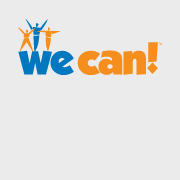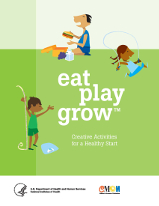Dem Bones
Early Childhood Health Lesson
Objective:
Learn the importance of calcium in building strong bones.
We Can! Messages
Drink fat-free and low-fat milk or water instead of sugar-sweetened beverages.
Eat a variety of vegetables daily.
Engage in 60 minutes of moderate activity on every day of the week.
Reduce sedentary activity.
Limit screen time to less than 2 hours daily.
National Pre-K–2nd Grade Health Performance Standards
Demonstrate healthy practices and behaviors to maintain or improve personal health.
Adult Message
Calcium and weight-bearing physical activity are essential to healthy bone growth.
Developing Preschool Readiness Skills
Fine motor control and gross motor development, developing body awareness and coordination.
Program Content
Themed lessons incorporating art, science, literacy, movement and music support a
multi-disciplinary approach to teaching young children and adults.
Program Length: 70 minutes
Introduction/Discussion
Materials: Name stickers, markers
Welcome families with name stickers and “hello” song. Ask families to feel their arms, fingers,
and knock on their heads. What is so hard? Your bones! A baby has about 300 bones, adults
have 206. (As children grow, their bones fuse together.) Introduce families to the skeletal system, describing how the bones are stiff, but can still break! Bones are strengthened by the
nutrients in our food and one important nutrient is calcium. Calcium is the building block
of bones. Since bones are constantly repairing and building, we need to feed our bones the
building blocks. Fat-free and low-fat milk are high in calcium and vitamin D. Vitamin D is also
important for bone growth and health.
Lead children in a jumping game to build bones. (Weight-bearing activities stimulate bone growth.)
Visual References: Pictures of the skeletal system and a skeletal figure. Pictures of foods that
contain calcium and are good for bones.
Key Teaching Messages
- Calcium and vitamin D are essential for healthy bone growth and can be found in fat-free and low-fat milk, fat-free and low-fat milk products, some vegetables and other foods.
- Bones are in constant stages of growth and regeneration, even into adulthood.
- Weight-bearing physical activity, such as walking, running, climbing stairs, and dancing, are best for building strong bones.
Art Activity: Bone Collage With Balsa Wood
Children and adults work together to create a collage while learning about the importance of calcium and physical activity for healthy bone development and growth.
Materials: Oak tag paper, bone cut-out shapes, balsa wood, glue, and markers.
Set-up: At each seat, place: pre-cut bone shapes, craft sticks, balsa wood, oak tag paper, and markers.
Demonstrate how to connect the bone shapes to the balsa wood. Discuss and identify the different bone shapes. Lead a discussion on the importance of keeping bones strong and the variety of ways that families can keep bones healthy by eating foods with calcium (low-fat or fat-free milk, yogurt and cheese, fortified soy beverages, broccoli, soybeans) and by including physical activity into their daily routines. When the children are finished coloring and working on their collages, write their names on the project with a magic marker.
Clean-up: Give children a 5 minute warning. Always let children know that you will be transitioning and ending the project soon. After the warning, sing a clean-up song to focus children and encourage participation in the clean-up process. One example: “Clean up, clean up, one, two, three. I’ll help you and you help me. Clean up, clean up, one, two, three. I’ll help you and you help me.”
Physical Activity: Movement/Music
Weekly Structure: Warm-up, Active Play Time, Movement/Music (song/activity), Cool-down. Children should do at least 60 minutes (1 hour) or more of physical activity each day.
Warm-up:
Marching Movement Song
We’re marching, marching, marching
We’re marching in a circle
We’re marching, marching, marching until it’s time to stop!
We’re jumping, jumping, jumping
We’re jumping in a circle,
We’re jumping, jumping, jumping until it’s time to stop!
(add hopping, stomping, running, tiptoeing, etc.)
In and Out Circle Song
Let’s go in and in and in
And out and out and out
And in and in and in and in
And out and out and out!
Active Play Time:
Do 5 or 10 minutes of each exercise
- Playing Tag
- Hopscotch
- Jumping Jacks
- Jumping (one foot, together then apart, front to back)
Movement/Music:
Do activities and sing songs that encourage isolated movements to highlight bones. Songs: 'Dem Bones (see below), Head & Shoulders, Simon Says, Open Shut Them, Hokey Pokey, Itsy Bitsy Spider, and Five Little Monkeys.
Cool-down:
It is important for the body to cool down gradually.
- Breathing–Place hands on belly or lower back. Inhale and fill the lungs. Feel the abdomen and ribs inflate. Exhale and empty the lungs. Feel the chest and abdomen relax.
- Yoga Moves
- Downward Dog–Have the children make a bridge with their bodies. From here you can kick one leg up at a time and start to stretch body long.
- Tree Pose–Have the children balance on one leg, bending their other leg at a 90 degree angle, stretching their hands above their heads.
- The Horse–Stand in place for 30 seconds with a wide stance and knees bent (like a halfway down squat position).
Group Storytime
Dinosaur Stomp! by Paul Stickland
Dem Bones by Bob Barner
The Skeleton Inside You by Philip Balestrino
Healthy Snack
Offer high calcium snacks like fortified orange juice (not all juice is fortified) and low-fat string cheese. An educator-led discussion will give children and adults the opportunity to discuss strategies for incorporating low-fat foods with high levels of calcium and vitamin D.
Encourage children to wash hands with soap and warm water before eating snack. Hand Washing Strategy: Wash hands for 20 seconds to fight off all germs and then rinse well under running water. Sing the ABC Song while you wash.
Review Family Handout
Goal: Consume enough calcium every day.
Facts of the Week: Fat-free or low-fat milk, cheese, and yogurt provide essential nutrients for
healthy bone growth such as calcium, potassium, vitamin D, and protein.
At-Home Strategies:
- Eat more fat-free or low-fat milk, yogurt, and cheese.
- Decrease sedentary behavior, increase walking.
- Use fat-free or low-fat milk instead of water to make oatmeal and pudding with no added sugar.
- Drink fat-free or low-fat milk, or a fortified soy beverage, at meals.
- Some vegetables like broccoli, and nuts like almonds have calcium in them.
‘Dem Bones Song
The foot bone connected to the leg bone,
The leg bone connected to the knee bone,
The knee bone connected to the thigh bone,
The thigh bone connected to the back bone,
The back bone connected to the neck bone,
The neck bone connected to the head bone,
Go, Bones, Go! (boom, boom, boom)
Dem bones, dem bones gonna walk aroun’,
Dem bones, dem bones, gonna walk aroun’,
Dem bones, dem bones, gonna walk aroun’,
Go, Bones, Go! (boom, boom, boom)
The head bone connected to the neck bone,
The neck bone connected to the back bone,
The back bone connected to the thigh bone,
The thigh bone connected to the knee bone,
The knee bone connected to the leg bone,
The leg bone connected to the foot bone,
Go, Bones, Go! (boom, boom, boom)
Dem bones, dem bones gonna walk aroun’,
Dem bones, dem bones, gonna walk aroun’,
Dem bones, dem bones, gonna walk aroun’,
Go, Bones, Go! (boom, boom, boom)
Lesson Visuals
- Skeleton with bones labeled
- Skeleton in pieces
- Outlined Bones
- Hand with skeletal structure
- The Hidden Milk Truth
Dem Bones
Early Childhood Health Lesson
Skeleton with bones labeled: cranium, mandible, sternum, humfrus, ribs, spine, radius, unla, tibia, fibula, tarsals, femur, ilium
The Hidden Milk Truth
Whole Milk
Vitamins A & D
Nutrition Facts
Serving Size 1 cup
Calories 150
Total Fat 8 g
Calcium equals 30% of your daily value.
Low-Fat Milk
2% Reduced Fat Milk Vitamins A & D
Nutrition Facts
Serving Size 1 cup
Calories 120
Total Fat 5 g
Calcium equals 30% of your daily value.
Fat-Free Milk
Vitamins A & D
Nutrition Facts
Serving Size 1 cup
Calories 80
Total Fat 0 g
Calcium equals 30% of your daily value.
Family Health Handout
Dem Bones
Benefits of Calcium and Physical Activity:
- Helps build and maintain strong bones!
- Calcium and other nutrients can be found in milk, milk products, some vegetables, and other foods.
Farmers Market or Green Cart Shopping List
Try bone-building broccoli from your local market this week!
Family Goal
Goal: Increase servings of calcium every day. Try fat-free or low-fat milk,
cheese or yogurt, broccoli, almonds, or soybeans.
Monday: We added today.
Tuesday: We added today.
Wednesday: We added today.
Thursday: We added today.
Friday: We added today.
Saturday: We added today.
Sunday: We added today.
Fact of the Week
Fat-free or low-fat milk, cheese and yogurt provide essential nutrients such as calcium, potassium, vitamin D and protein for healthy bone growth.
Surprising Fact
Children 1–3 years of age need 500 mg of calcium each day. (1 full cup is 300 mg)
Children 4–8 years of age need 800 mg of calcium each day. (1 full cup is 300 mg)
Don’t forget, grown-ups need calcium too!
Strategy
Use fat-free or low-fat milk instead of water to make oatmeal and other hot cereals.
Health Tip
Some children are allergic to milk and milk products, but they still need calcium. Ask your doctor for creative ways to include calcium in their diet. (Try broccoli!)
At-Home Tools
Bone Books
Dinosaur Stomp! by Paul Stickland
Dem Bones by Bob Barner
The Skeleton Inside You by Philip Balestrino
New Bone Words to Use
- Bone
- Low-fat
- Milk
- Jump
- Bounce
Did you know…
Calcium is found in broccoli and fortified soy beverages.
Activities for Building Bones
Bouncy Bones!
Create a safe space to bounce. Practice your
bouncing skills by bouncing on one foot,
two feet, forwards and backwards. Challenge:
change direction and speed.
Long Jump
Compare how far each family member can
jump from a standing position.
Bone Building Recipes
Breakfast
Vanilla fat-free or low-fat yogurt topped
with cereal and blueberries.
Lunch
Spread tuna fish on top of a whole wheat
English muffin. Add a slice of tomato and
cover with low-fat cheddar cheese. Finish
dish by warming for 1 minute to melt cheese
Snack
One cup of fat-free or low-fat milk and
banana slices.
| Back to Table of Contents | Back to Top |
NIH Publication No. 13-7818
April 2013











